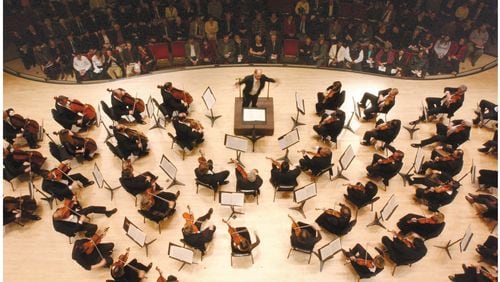As expected, the 11:59 p.m. Saturday deadline in the Atlanta Symphony Orchestra’s collective bargaining agreement negotiations passed without a deal being forged between management and the musicians.
The two sides have conducted ongoing negotiations since early this year, but last week it became clear, as details of each side's latest proposals leaked out, that a huge distance remained to be bridged.
A statement released just past midnight by the Atlanta Symphony Orchestra Players Association said that the musicians believe they are being locked out by ASO management. It was followed momentarily by a statement from ASO management that warned that the 2014-15 season, which is scheduled to open Sept. 25, may be delayed or cancelled.
Both statements are included below in their entirety.
Come back to the AJC's Arts & Culture blog Sunday for updates.
The Players Association statement:
Atlanta, GA September 7, 2014 12:01AM
As of midnight September 7th, 2014, ASO President and CEO Stanley Romanstein had refused all requests to meet with the Musicians during the final hours before the 2012-2014 CBA expired, forcing them to submit their most recent proposal electronically. The Musicians emphasized in their proposal that they wish to avoid a labor dispute and propose to continue negotiating while working under the concessionary 2012-14 contract. The musicians have received no response; it appears that the Woodruff Arts Center has locked out the Musicians of the Atlanta Symphony Orchestra for the second time in as many years.
In over eight months of negotiations, the Woodruff Arts Center and ASO Managements have displayed no willingness to find a workable agreement. They have refused to meet in person during the final days before our existing contract expired, and obstinately cling to the concessionary terms of their “last, best, and final offer,” under which the musicians would continue to hemorrhage income and lose orchestra positions.
Stanley Romanstein publicly accused the Musicians of not being willing to explore alternative health care solutions. Not only is that claim false – but the Musicians have offered the WAC healthcare solutions that would yield a greater savings without cutting into musician compensation any further.
According to the last, best, and final offer presented by the Woodruff Arts Center, the WAC has $3.75 million dollars available to further reduce the size of the orchestra by one third through a voluntary retirement incentive, and yet they will not apply such funding towards an agreement that we can sign. $3.75 million dollars exceeds the amount necessary to fund the musicians proposed increases. This is a WAC attempt to forever deprive the orchestra of its ability to function in the first league of orchestras.
The WAC has not demonstrated through their actions an understanding in the last two years of what is required to sustain a great American Orchestra – either artistically or financially. Because of this, the musicians can not afford to give up control to the WAC in determining the size of the orchestra.
The cost of the compensation package of Atlanta Symphony Orchestra Musicians was $12.2 million dollars in 2012. The cost of the compensation package as outlined in the Musicians’ proposal of September 6th will be $11.68 million dollars in 2018, the fourth year of the proposed agreement. Under the Musicians’ proposal, the orchestra’s costs will be less in 2018 than they were six years prior in 2012.
Orchestra management's statement:
Despite months of Collective Bargaining Agreement (CBA) discussions, the Atlanta Symphony Orchestra Players Association and Orchestra management have not reached an agreement on a new contract. As a result, the contract with the musicians’ union has expired, effective 12:00 midnight on Saturday, September 6, 2014. This development may delay or cancel portions of the scheduled 2014-15 season, which is set to open on Thursday, September 25, 2014.
Progress has been very slow, despite eight months of negotiations and ongoing transparency regarding the organization’s finances.
“We are all extremely disappointed that we do not have a new contract,” said Atlanta Symphony Orchestra (ASO) President Stanley E. Romanstein, Ph.D. “While we value the art and the artists of the ASO enormously, we believe we must develop a new model that will allow us to balance our artistic and financial needs. Clearly, that is not the model we have today.”
The ASO has had 12 consecutive years of deficit operations. In the recently completed 2013 – 2014 fiscal year, it had a $2 million deficit, even with a significant contribution from ASO Presents, the concert promotional arm of the ASO. Accumulated debt is approximately $5 million. The ASO endowment has declined to about $70 million today as the Orchestra has taken additional distributions of $18 million to cover its accumulated deficits.
The organization’s financial woes would be even more pronounced if it wasn’t a division of the Woodruff Arts Center (WAC). Conservatively, the WAC provides about $3.7 million in annual support by absorbing unallocated expenses and contributing to support the art. The ASO is one division of the Woodruff Arts Center which also includes the Alliance Theatre, Arts for Learning and the High Museum of Art.
“The Atlanta Symphony Orchestra’s donor base has been very generous, especially considering the long-term financial trends of the ASO,” said Woodruff Arts Center President and CEO Virginia Hepner. “But, these donors have told us that we must balance our budget in order to expect continued support. It’s really critical that we find a contemporary operating model for the ASO.”
In its most recent proposal, ASO Management offered to increase musician salaries by 4.5 percent over the life of a four-year contract plus a share (22%) of any budget surpluses. The proposal called for musicians to shoulder more of the costs for health care, in line with what ASO staff pays for its health care costs. Management has also proposed flexibility in determining how and when vacancies on the orchestra are filled in order to balance the artistic and financial needs of the orchestra.
Since the last contract was signed in 2012, expenses have declined but sales for the classical season have declined more dramatically as cost-conscious consumers favored single-ticket purchases over season subscriptions. This trend also put downward pressure on sponsorships.
ASO staff responded to these challenges by offering new purchase options, such as “build your own season,” and new formats like “First Fridays,” which are aimed to keep commuters in town after work with earlier concerts. In addition, ASO Presents, the concert promotional unit of the ASO, has dramatically increased the number of popular music concerts it produces in Symphony Hall, adding to ASO revenues. These adjustments have made a positive impact, but have not been enough to close the annual operating gap.
““We are pleased with some of the progress we have made over the last two years and we are grateful for the significant role the musicians played in helping reduce our costs. But we still have work to do to reverse the financial deficits that have been experienced for the past years,” said Atlanta Symphony Orchestra Board Chairman Karole Lloyd. “I remain firm in the belief that by working together — board, musicians, staff, and community — we will eventually achieve our goal: a vibrant, financially stable, world class Atlanta Symphony Orchestra which will serve this community for generations to come.”
“We are all musicians or music enthusiasts at the Atlanta Symphony, and we are all striving for the same thing — a thriving classical music community that will flourish for decades to come,” said Dr. Romanstein. “We hope we can return music to the stage very soon.”
About the Author



/cloudfront-us-east-1.images.arcpublishing.com/ajc/P7DYBH6TO7FEKG4SUXQQKADRXE.jpg)


